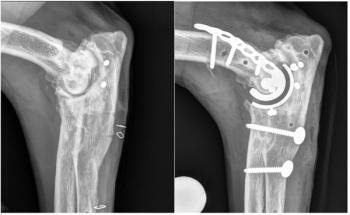
The use of gabapentin to help manage anxiety in dogs
For some veterinary patients, the anti-anxiety effects of a single medication might not be enough. When monotherapy is insufficient, consider adding this drug to your treatment plan.
GrasePhoto/stock.adobe.com
The use of psychoactive pharmaceuticals in veterinary behavior medicine has proved invaluable in managing anxiety-based disorders. Without the appropriate and judicious use of these medications, many dogs would be much less likely to respond to treatment with environmental management and behavior modification therapy.
Medications such as fluoxetine and sertraline (selective serotonin reuptake inhibitors [SSRIs]) and clomipramine (a tricyclic antidepressant [TCA]) can successfully treat patients affected by conditions such as separation anxiety, noise phobia and fear-based aggression. In some cases, however, use of a single pharmaceutical agent doesn't provide sufficient anti-anxiety effects to achieve a suitable outcome. When a patient fails to respond to monotherapy with an SSRI or a TCA, veterinarians have three options:1-3
1. Increase the dose of the medication if the typical maximum dose has not been reached and the patient has not shown undesirable side effects.
2. Switch to a different drug.
3. Augment the first drug with a second drug.
If the first two steps prove ineffective in reducing the intensity or frequency of the patient's fear or anxiety, combination drug therapy is a viable option. Numerous possible combinations of agents can be used to manage particular cases. In this article, we review the use of gabapentin in dogs for treating anxiety-related conditions.
Indication and dosage
Traditionally, gabapentin has been utilized in veterinary medicine for management of neuropathic pain and as an anticonvulsant.4 However, in human medicine it has also been used to treat patients with social anxiety and panic disorder.5 In the last several years veterinary behaviorists have used gabapentin as an adjunctive therapy for anxiety in dogs and cats. In dogs, it is frequently used in the treatment of generalized anxiety, impulsivity, phobias and panic disorders, and compulsive disorders.3
Generally, gabapentin is used as an adjunctive medication when an SSRI or TCA has already been prescribed but has failed to significantly reduce the intensity of the patient's fear or anxiety. Gabapentin has frequently been given alongside fluoxetine, sertraline, paroxetine and clomipramine in treating these conditions.
Gabapentin is a structural analog of gamma-aminobutyric acid (GABA), but it does not interact with GABA receptors nor does it affect GABA uptake or degradation.4 Gabapentin binds selectively to the alpha-2-delta subunit on voltage-sensitive calcium channels, thereby reducing the release of excitatory neurotransmitters, including glutamate, from presynaptic neurons.5 These calcium channels are upregulated when nerves are stimulated in conditions such as epilepsy, neuropathic pain and anxiety.4,5 Blocking these channels has minimal effect on normal neurons but suppresses stimulated neurons.4
In dogs, gabapentin is metabolized into N-methyl-gabapentin.6 It has greater than 80% systemic oral availability,7 and absorption is not affected by food. Maximum blood levels are achieved in one to three hours and it has an elimination half-life of three to four hours.6 Gabapentin is excreted almost completely by the kidneys and it does not rely on hepatic biotransformation,7 making it a good choice for patients with hepatic disease.
Dosages can vary, but commonly gabapentin is dosed in dogs at 5-30 mg/kg up to three times daily,3 though in our own patients we have used 10-40 mg/kg up to three times daily as well. Gabapentin has also been used on an as-needed basis to achieve anxiolysis at 30-60 mg/kg one to two hours before an anticipated stressful event, such as a veterinary visit.
Experts suggest beginning at the low end of the dose range and gradually titrating up to effect with dose adjustments occurring about seven days apart, allowing time to evaluate the effect. Wean patients off gabapentin gradually to reduce the potential for seizures.8 Also, when using this drug in conjunction with antacids, separate dosing by two hours.8 Keep in mind that gabapentin can cause a false positive result for urinary protein, and concomitant use of morphine or hydromorphone can result in increased activity of gabapentin as well as causing a reduced activity of the opioid.8
While we're discussing dogs here, it's worth noting that in cats, gabapentin is increasingly being used prior to veterinary visits at a dose of 10 mg/kg up to 100 mg/cat given 1.5 to 3 hours before an appointment.9
The drug is available in 100-, 300- and 400-mg capsules as well as 600- and 800-mg tablets. Use caution when prescribing or administering prepared liquid gabapentin since some formulations contain xylitol as a flavoring agent.
Potential side effects
While sedation and ataxia can occur with the use of gabapentin, there have been no reported serious safety issues in animals.4 In our experience, other possible side effects include gastrointestinal distress-such as loss of appetite, vomiting and diarrhea-and increased anxiety or agitation.
These side effects are typically transient and mild. In some cases, however, effects can be more prolonged and serious. Be sure to educate clients about possible side effects and tell them to contact you or another veterinarian immediately with any concerns.
If you encounter adverse effects, you can decrease the dose (50% reduction is common) or, in more severe cases, discontinue the medication completely. While compounds with longer half-lives (such as SSRIs) can be discontinued abruptly, shorter-acting compounds, such as gabapentin, should be gradually tapered to minimize withdrawal signs. Gradual withdrawal is also helpful in cases when there is a need to determine the lowest effective dose.
Dose adjustments for gabapentin can be made every one or two weeks. There is no need to withdraw these medications before anesthesia, but consider reducing premedication sedation to minimize interactions.
In order to monitor hepatic and renal function, perform baseline premedication database testing, including a complete blood count, serum chemistry profile and urinalysis. Repeat this testing one or two months after starting the medication and then again every six to 12 months.
Summary
Gabapentin is an excellent option in managing anxiety when previous therapies alone have proven to be insufficient. It may be used situationally, prior to predictable stressful events, or administered daily in combination with an SSRI or TCA. With judicious management of dosing and close communication with owners, gabapentin can be an effective and safe adjunctive agent for the treatment of behavioral disorders.
References
1. Crowell-Davis SL, Murray T. Combinations. In: VeterinaryPsychopharmacology. Ames, Iowa: Blackwell Publishing, 2006:234-240.
2. Sherman BL, Mills DS. Canine Anxieties and Phobias: An Update on Separation Anxiety and Noise Aversions. Vet Clin North Am Small Anim Pract 2008;38:1081–1106.
3. Landsberg GM, Hunthausen W, Ackerman L. Pharmacologic intervention in behavior therapy. In: Behavior Problems of the Dog and Cat. 3rd ed. Philadelphia: Saunders, 2013:113-138.
4. Riviere JE, Papich MG. Anticonvulsants. In: Veterinary Pharmacology and Therapeutics. 9th ed. Hoboken, New Jersey: John Wiley & Sons, 2013: 493-508.
5. Stahl SM. Stahl's Essential Psychopharmacology: Neuroscientific Basis and Practical Applications. 4th ed. New York: Cambridge University Press, 2013.
6. KuKanich B, Cohen RL. Pharmacokinetics of oral gabapentin in greyhound dogs. Vet Jour 2011;187:133-135.
7. Radulovic LL, Türck D, Hodenberg von A, et al. Disposition of gabapentin (neurontin) in mice, rats, dogs, and monkeys. Drug Metab Dispos 1995;23:441-448.
8. Plumb D. Plumb's veterinary drug handbook. 6th ed. Ames, Iowa: Blackwell Publishing, 2008;415-417.
9. van Haaften KA, Forsythe LRE, Stelow EA, et al. Effects of a single preappointment dose of gabapentin on signs of stress in cats during transportation and veterinary examination. J Am Vet Med Assoc 2017;251:1175-1181.
Dr. John J. Cirribassi is retired from practice and lives in Carol Stream, Illinois. Dr. Kelly Ballantyne owns
Newsletter
From exam room tips to practice management insights, get trusted veterinary news delivered straight to your inbox—subscribe to dvm360.






